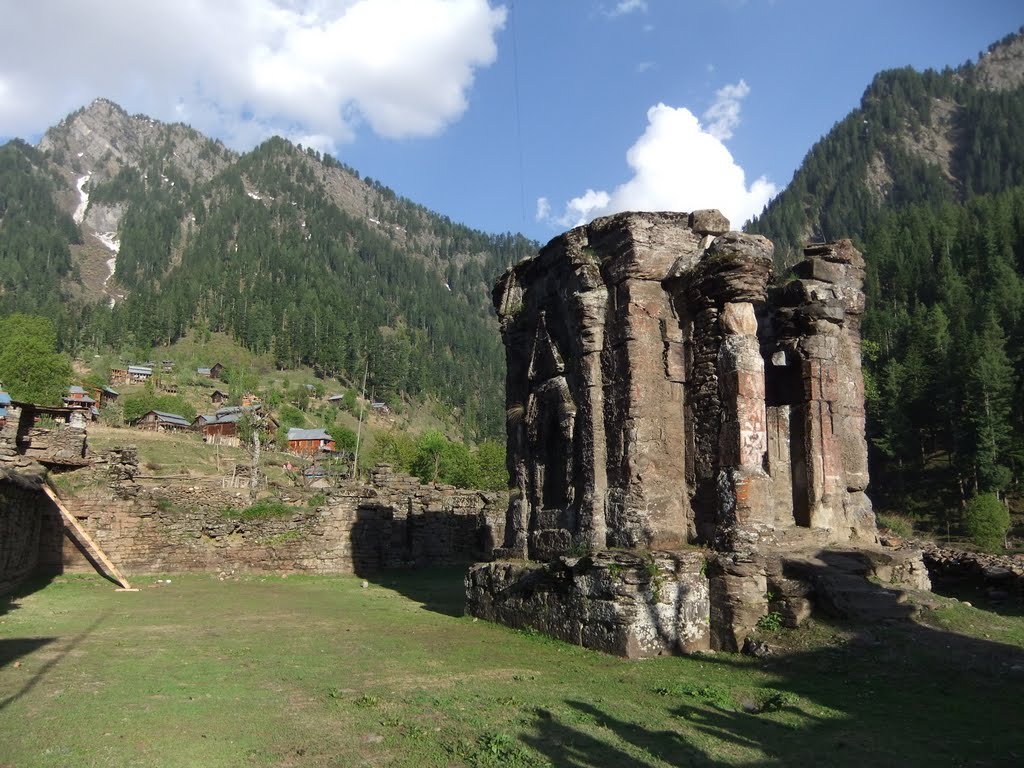The Sharda temple is so ancient that Kashmir State was earlier known as 'Sharada Peeth'. It is at this temple that Sankaracharya received the right to sit on the Sarvanjnanapeetham or Sarvajna peetha(Throne of Wisdom).
Sri Sharda Temple is situated at a height of about 3400 metres. Surrounded by snow-capped mountains and dense forests, inhabited by wild beasts, the temple inspires travellers with a feeling of awe and strangeness. Far from the ignoble strife of the madding crowds, the spot is pecularly divine with supreme peace.
To fulfil this aim in life, Sankara travelled all over Bharata and visited Sharda Temple in Kashmir. There he vanquished many learned disputants and seated himself triumphantly on the throne of the omniscience. This part of kashmir was a flourishing stretch of land, housing scholars and pandits of high Vedic learning.
It is a very good example of architecture. The Śāradā image at Shringeri Sharadamba temple was once said to have been made of sandalwood
Sharada Peeth ([Urdu]]: شاردا پیٹھ), located near Sharda in Azad Kashmir, at the de facto border of India and Pakistan (Line of Control) (LOC), was the famous temple of the goddess Sarasvatī (Sharda) on the banks of Neelum River in Azad Kashmir.
Shakti Peethas are shrines or divine places of Shakti formed due to the falling of body parts of the corpse of Sati Devi, when Shiva carried it and wandered throughout Aryavartha in sorrow. There are 51 Shakti Peeth linking to the 51 alphabets in Sanskrit.
Each temple has shrines for Shakti and Kalabhairava. Sharada Peeth is one of the 18 Maha Shakti Peetha. Devi's Right hand is said to have fallen here. The Shakti worshiped here is the goddess of knowledge and education, Saraswathi otherwise known as Sarada.
Sage Shandilya used to meditate in Sharada-van. Near the temple of Sree Sharada Devi, there is 'Amarkund' lake. It is believed that Sage Shandilya got the 'darshan' of Sree Sharada Devi there.
Do:
- Do pray your Ishta Devata before pilgrimage to Temple.
- Do contact Temple Devasthanam information centre for enquiry, temple information and for Pooja details etc.
- Do reserve your travel and accommodation at Temple well in advance.
- Do bath and wear clean clothes before you enter the temple.
- Do concentrate on God and Goddess inside the temple.
- Do maintain silence and recite your Istamantram to yourself inside the temple.
- Do observe ancient custom and traditions while in Temple.
- Do respect religious sentiments at Temple.
- Do deposit your offerings in the hundi only.
Don't s:
- Do not come to Temple for any purpose other than worshipping of God and Goddess.
- Do not smoke at Temple.
- Do not consume alcoholic drinks at Temple.
- Do not eat non-vegetarian food in the Kshetram.
- Do not approach mediators for quick Darshanam. It may cause inconvenient to others.
- Do not carry any weapon inside the temple.
- Do not wear any head guards like helmets, caps, turbans and hats inside the temple premises.
- Do not perform Sastanga Pranama inside the Sanctum Sanctorum.
- Do not take much time while performing Sparsa Darshanam to God in Garbhagriha.
- Do not buy spurious prasadams from street vendors.
- Do not encourage beggars at Temple.
- Do not spit or create nuisance in the premises of the temple.
